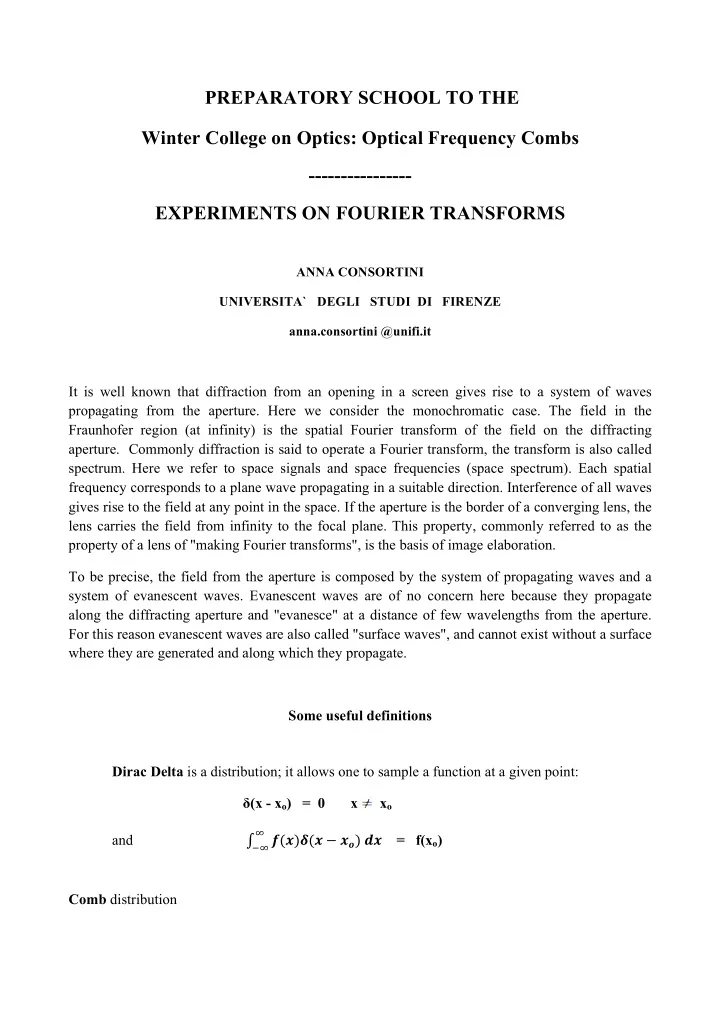

PREPARATORY SCHOOL TO THE Winter College on Optics: Optical Frequency Combs ---------------- EXPERIMENTS ON FOURIER TRANSFORMS ANNA CONSORTINI UNIVERSITA` DEGLI STUDI DI FIRENZE anna.consortini @unifi.it It is well known that diffraction from an opening in a screen gives rise to a system of waves propagating from the aperture. Here we consider the monochromatic case. The field in the Fraunhofer region (at infinity) is the spatial Fourier transform of the field on the diffracting aperture. Commonly diffraction is said to operate a Fourier transform, the transform is also called spectrum. Here we refer to space signals and space frequencies (space spectrum). Each spatial frequency corresponds to a plane wave propagating in a suitable direction. Interference of all waves gives rise to the field at any point in the space. If the aperture is the border of a converging lens, the lens carries the field from infinity to the focal plane. This property, commonly referred to as the property of a lens of "making Fourier transforms", is the basis of image elaboration. To be precise, the field from the aperture is composed by the system of propagating waves and a system of evanescent waves. Evanescent waves are of no concern here because they propagate along the diffracting aperture and "evanesce" at a distance of few wavelengths from the aperture. For this reason evanescent waves are also called "surface waves", and cannot exist without a surface where they are generated and along which they propagate. Some useful definitions Dirac Delta is a distribution; it allows one to sample a function at a given point: δ (x - x o ) = 0 x x o ! ! ( ! ) ! ( ! − ! ! ) ¡ !" = f(x o ) and ! ! Comb distribution ¡ ¡ ¡ ¡ ¡ ¡
¡ ! !"#$ ! ¡ = ! ( ! − ! ) ! ! ! ! allows one to sample a function f(x) in an infinite number of equidistant points, as can immediately seen from the definition of the Dirac delta function. More generally ! !"#$ ! , ! ¡ = ! ( ! − !" ) ! ! ! ! where b is the constant spacing between the steps. Obviously the previous case is the particular case where step space is b=1 . Examples of transform of functions and distributions Remember that the transform of a function is also called "spectrum" Function or distribution f(x) Fourier transform F( ν ) δ (x) Dirac delta 1 1 δ ( ν ) exp (2 π i ν o x) δ ( ν - ν o ) ! a ¡ ¡ ¡ exp(- π 2 ν 2 /a) Gaussian exp(- ax 2 ) a>0, Gaussian rect(x/2a) a>0 2a Sinc(2a ν ) Comb (x) Comb ( ν ) ! ! Comb(ax) | ! | Comb a ¡ ¡
EXPERIMENTS ¡ Here we show experimentally the following: Function Fourier transform (spectrum) 1 - Rect Sinc = [sin(arg)] /arg 2 - Circ [Bessel J 1 (arg)] /arg 3 - Gaussian Gaussian 5 - Comb Comb 1 - The Fourier transform of a rect(x) is shown by diffraction of laser light by different slits and by analysing the pattern (energy) on a distant screen. Fresnel region and Fraunhofer region are shown. Comments on the widths of the slits and corresponding Fourier patterns are made. 2 - The bidimensional transform of circ(r) is shown by diffraction of laser light by holes of two different dimensions. Measurements of the diameter of the central spot of the spectra (Airy patterns) are made by the students to confirm the relationship between the widths of the function and of its Fourier transform. 3 - Bidimensional transform: analysis of a Gaussian beam profile from the laser output (waist) up to far distance, where the Fourier transform (intensity) can be seen on a far screen. Comments on the width of the Gaussian beam and its transform. 4 - Diffraction by a number of different linear diffraction gratings. Demonstration, by measurements made by the students, of the inverse relationship between the line spacing of a gratings and the spacing of the corresponding diffracted comb, in three particular cases. Some examples of diffraction by bidimensional gratings. These experiments show the Fourier transforms, optically, in the space domain, where frequencies are "spatial frequencies". The results equally apply to time domain, where one has what we usually call "frequency", and to any other domain where the phenomena follow laws suitable to be expressed in terms of "regular" functions which can be represented in terms of Fourier transforms.
Recommend
More recommend